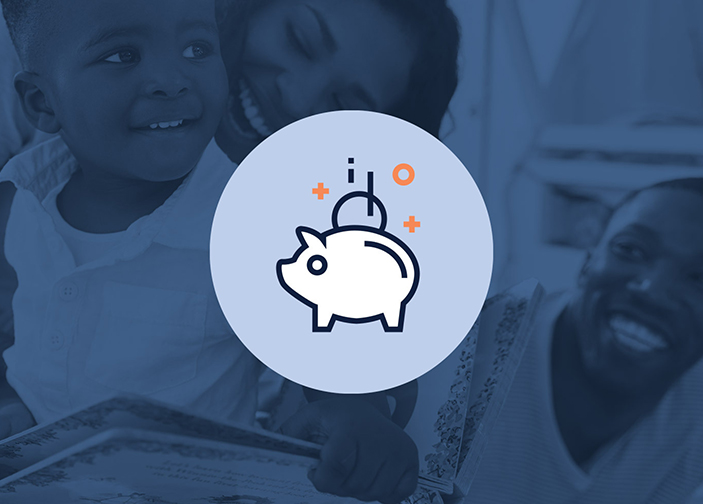College happens sooner than you think
Start saving and prepare for your student's future now with one of the nation's best 529 college savings plans.1


Saving doesn't have to be scary
With public tuition and living costs in Illinois currently averaging more than $26,000 per year2, saving for a child’s future can feel daunting, confusing, and a little scary. But even though you can’t slow their childhood or the fluctuating costs of college, you can still set your child up for success. Students who have savings for college are more likely to pursue post-secondary education, graduate and leave with less debt. Use our college savings calculator to see what you should be saving based on your student’s age — then put that money to work for you.
Words from the savings wise
Families just like yours made the decision to save for the future. See how they’re reaching their college savings goals with Bright Start 529.
The Morris family3
We kept coming back to Bright Start given how well it's performed and its reputation. It's professionally managed, so we can trust that we don't need to watch it every day. The cost savings are great, and it's less expensive than other funds we researched.
- Marlén Cortez Morris
- Chicago, IL

Here are some of our most common 529 plan questions
Anyone with a valid Social Security Number or Taxpayer Identification Number who is at least 18 years of age can open a Bright Start 529 account. Accounts can be opened online.
If your child ends up not needing the funds for college, you always have multiple options for your money:
- Your funds can be used to pay for a variety of eligible education expenses, including public or private colleges, universities, community colleges, professional and vocational schools, certain apprenticeship expenses or postgraduate programs in the United States—and even some schools abroad.1
- Your 529 can be used for student loan repayment up to a $10,000 lifetime limit per individual.1
- Up to $10,000 annually can be used toward K-12 tuition (per student).1
- You can transfer the funds to another eligible beneficiary, such as another child, a grandchild or yourself.
- If you just want the money back, you can withdraw the funds at any time. If funds are withdrawn for a purpose other than qualified higher education expenses, the earnings portion of the withdrawal is subject to federal and state taxes plus a 10% additional federal tax on earnings (known as the “Additional Tax”). See the Plan Description for more information and exceptions.
- Roll over funds to a Roth IRA. Limitations apply.2
- Or you can always wait because the funds never expire, and often the choice to go to school is a delayed decision. So if your child changes their mind down the road, your savings will still be available.
Footnotes
- 1Withdrawals for tuition expenses at a public, private or religious elementary, middle or high school can be withdrawn free from federal tax. For Illinois taxpayers, these withdrawals may include recapture of tax deduction, state income taxes well as penalties. Withdrawals for registered apprenticeship programs and student loans can be withdrawn free from federal and Illinois income tax. If you are not an Illinois taxpayer, these withdrawals may include recapture of tax deduction, state income tax as well as penalties. You should talk to a qualified professional about how tax provisions affect your circumstances. Apprenticeship programs must be registered and certified with the Secretary of Labor under the National Apprenticeship Act.↩
- 2For Illinois tax purposes, rollovers are permitted from an account to a Roth IRA without incurring federal and state income tax or penalties. State tax treatment of a rollover from a 529 plan into a Roth IRA is determined by the state where you file state income tax. There are conditions that must be met, including the 529 plan must have been in existence for at least 15 years.
You should talk to a qualified professional about how tax provisions affect your circumstances.↩
Qualified higher education expenses means, generally, the cost of tuition, fees, books, supplies and equipment required for the enrollment or attendance of a beneficiary at an eligible educational institution, certain costs of housing and food (room and board), the cost of computer or peripheral equipment, certain software, and internet access and related services if used primarily by the beneficiary during any of the years the beneficiary is enrolled at an eligible educational institution, as well as certain additional enrollment and attendance costs of beneficiaries with special needs. For both federal and Illinois tax purposes, any reference to a qualified higher education expense also includes a reference to (a) expenses for fees, books, supplies and equipment required for the participation of a beneficiary in an apprenticeship program and (b) amounts paid as principal or interest on any qualified education loan of either the beneficiary or a sibling of the beneficiary up to a lifetime limit of $10,000 per individual. Distributions treated as qualified higher education expenses with respect to the loans of a sibling of a beneficiary will count toward the limit of the sibling, not the beneficiary. Such loan repayments may impact student loan interest deductibility.
For federal but not Illinois tax purposes, any reference to a qualified higher education expense also includes a reference to tuition in connection with enrollment or attendance at a primary (i.e., elementary school) or secondary (i.e., middle school or high school) (together, referred to as “K-12”) public, private or religious school up to a maximum of $10,000 of distributions for such tuition expenses per taxable year per beneficiary from all 529 Plans.
State tax treatment of withdrawals is determined by the state where you file state income tax. Withdrawals for K-12 tuition expenses are not qualified withdrawals for Illinois tax purposes. Please consult with a tax advisor before withdrawing funds for any such expenses, rollovers or loan repayments.
You may request a withdrawal via your account online. Select the beneficiary you would like to withdraw the money for, click “Make a Withdrawal” on the lefthand navigation and follow the directions. You may also request a withdrawal using the Withdrawal Request Form.